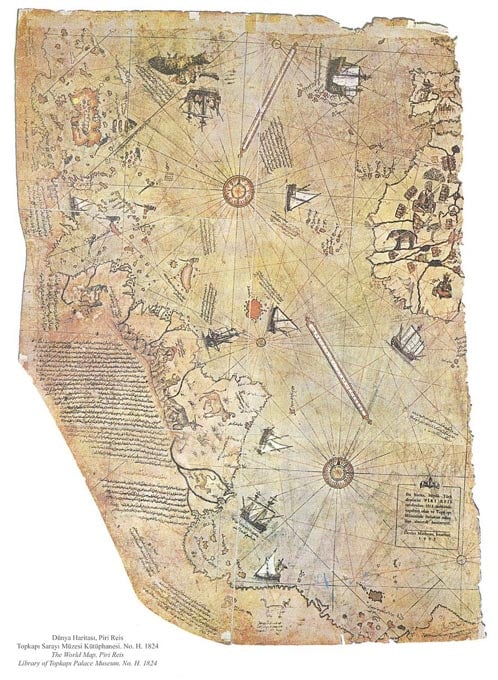Humanity has grown so old that it has forgotten its infancy, and the origin of man is shrouded in mystery.
Conventional wisdom states that humanity was primitive in the past
and then things started evolving until people emerged from the state of
barbarism to become smarter and more capable. New evidence however
suggests otherwise; it suggests that maybe the dawn of history was
characterized by forgotten high science and technology that far exceeds
modern man’s expectations of the distant past.
This view is as old as history. The ancients spoke of their past as being glorious. The account of Atlantis in Plato’s dialogues Timaeus is the most vivid memory we have of this golden age.

A few years later in 1929, a mysterious map from 1513 called the Piri Reis map was found in Istanbul. The map shows the coasts of Antarctica and South America with modern exactitude. This map rekindled the view on advanced ancient civilizations and gave it a solid ground.
More recently the book ‘Worlds Before Our Own’ (1978) by Brad Steiger exposed new facts in favor of early advanced societies. Steiger found that some advanced human artifacts were located in the lowest primordial geologic strata whereas primitive ones are in upper strata. He labeled these anachronistic items that were seemingly out of their proper place in time, “Out-of-Place Artifacts”(OPA). His book fueled a series of later works that characterized the past 30 years with a sort of rebellion towards the current worldview of the ancient past.

Bauer, S. (2007). The history of the ancient world: From the earliest accounts to the fall of Rome. New York: W.W. Norton.
Cook, M., & Cook, M. (1967). Science and Mormonism; correlations, conflicts and conciliations,. Salt Lake City: [Deseret News Press].
Cox, R. (1997). The pillar of celestial fire: And the lost science of the ancient seers. Fairfield, Iowa: Sunstar Pub.
Dey, G. (2012). Gospel train. S.l.: Authorhouse.
Fix, W. (1978). Pyramid odyssey. New York: Mayflower Books.
Harold G. Coffin, (1969). Research on the Classic Joggins Petrified Trees. Creation Res. Soc. Annual pp. 35-44, 70
LaViolette, P. (2005). Earth under fire: Humanity's survival of the Ice Age. Rochester, Vt.: Bear & Co.
Malkowski, E. (2010). Ancient Egypt 39,000 BCE: The history, technology, and philosophy of Civilization X. Rochester, Vt.: Bear & Co.
New York Herald Tribune newspaper, 16 Feb. 1947.
Rupke, N.A., (1966). Prolegomena to a Study of Cataclysmal Sedimentation. Research Society Quarterly, Nutley, 3(1), 16-37.
Wohl, E. (2000). Inland flood hazards: Human, riparian, and aquatic communities. Cambridge: Cambridge University Press.
This view is as old as history. The ancients spoke of their past as being glorious. The account of Atlantis in Plato’s dialogues Timaeus is the most vivid memory we have of this golden age.

Medieval manuscript of Plato’s Timeas, Latin translation. (Public Domain)
One of the more modern researchers to immerse himself into a serious
study of Plato’s account was the U.S. Congressman Ignatius Loyola
Donnelly (1831 – 1901). He believed Atlantis to be historically accurate
and gathered all the then-available evidence in favor of an early
mighty civilization that was far more advanced than it had any right to
be.A few years later in 1929, a mysterious map from 1513 called the Piri Reis map was found in Istanbul. The map shows the coasts of Antarctica and South America with modern exactitude. This map rekindled the view on advanced ancient civilizations and gave it a solid ground.
More recently the book ‘Worlds Before Our Own’ (1978) by Brad Steiger exposed new facts in favor of early advanced societies. Steiger found that some advanced human artifacts were located in the lowest primordial geologic strata whereas primitive ones are in upper strata. He labeled these anachronistic items that were seemingly out of their proper place in time, “Out-of-Place Artifacts”(OPA). His book fueled a series of later works that characterized the past 30 years with a sort of rebellion towards the current worldview of the ancient past.
- The Babylonian map of the world sheds light on ancient perspectives
- Piri Reis Map - Evidence of Ancient Technology?
- The Controversial Origins of the Maine Penny, A Norse Coin found in a Native American Settlement

Map of the world by Ottoman admiral Piri Reis, drawn in 1513. (Public Domain)
Ancient Creation and Destruction
“When the first atomic bomb exploded in New Mexico, the desert sand turned to fused green glass. This fact, according to the magazine Free World, has given certain archaeologists a turn. They have been digging in the ancient Euphrates Valley and have uncovered a layer of agrarian culture 8,000 years old, and a layer of herdsman culture much older, and a still older caveman culture. Recently, they reached another layer, a layer of fused green glass.” (New York Herald Tribune, 1947)Continue reading on the original site.
References
Amos W., Hoffman J. I. 2010. Evidence that two main bottleneck events shaped modern human genetic diversity. Proc. R. Soc. B 277, 131–137. From http://www.ncbi.nlm.nih.gov/pmc/articles/PMC2842629/Bauer, S. (2007). The history of the ancient world: From the earliest accounts to the fall of Rome. New York: W.W. Norton.
Cook, M., & Cook, M. (1967). Science and Mormonism; correlations, conflicts and conciliations,. Salt Lake City: [Deseret News Press].
Cox, R. (1997). The pillar of celestial fire: And the lost science of the ancient seers. Fairfield, Iowa: Sunstar Pub.
Dey, G. (2012). Gospel train. S.l.: Authorhouse.
Fix, W. (1978). Pyramid odyssey. New York: Mayflower Books.
Harold G. Coffin, (1969). Research on the Classic Joggins Petrified Trees. Creation Res. Soc. Annual pp. 35-44, 70
LaViolette, P. (2005). Earth under fire: Humanity's survival of the Ice Age. Rochester, Vt.: Bear & Co.
Malkowski, E. (2010). Ancient Egypt 39,000 BCE: The history, technology, and philosophy of Civilization X. Rochester, Vt.: Bear & Co.
New York Herald Tribune newspaper, 16 Feb. 1947.
Rupke, N.A., (1966). Prolegomena to a Study of Cataclysmal Sedimentation. Research Society Quarterly, Nutley, 3(1), 16-37.
Wohl, E. (2000). Inland flood hazards: Human, riparian, and aquatic communities. Cambridge: Cambridge University Press.